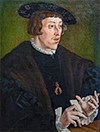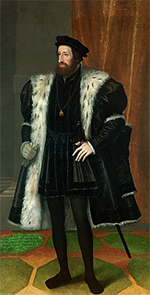Ferdinand I: King of Germany, Holy Roman Emperor
Ferdinand I was King of Germany for more than four decades and Holy Roman Emperor for several years in the 16th Century. He saved Vienna from the invading Ottomans during a great siege, and he presided over the Peace of Augsburg, one of the most far-reaching religious agreements in the history of the Catholic Church. He was born on March 10, 1503, in Alcalá de Henares, in Spanish Castile. His father was Philip of Spain, and his mother was Joanna I of Castile. Young Ferdinand grew up in Spain and went into service of his older brother, Charles, who became King Charles I of Spain in 1518. (Their father had died in 1506.) When their grandfather, the Holy Roman Emperor Maximilian I, died the following year, Charles took that throne and gave his brother the Austrian lands to administer. Ferdinand served as Archduke of Austria for more than four decades. He lived there and learned the German language and the culture of Austria and of the German territories. Maximilian had, in 1515, arranged Ferdinand's marriage to Anne Jagiellonica, whose father was King Vladislau II of Bohemia and Hungary. That monarch died the very next few year, and his son Louis succeeded him. 
Ferdinand succeeded his brother-in-law, Louis II of Hungary, as King of Bohemia, Croatia, and (eventually) Hungary after the latter's death in battle in 1526. Ferdinand claimed the Hungarian throne after a protracted battle against by a Transylvanian noble named John Zápolya. After a series of defeats. Zápolya fled Hungary and threw in his lot with the Ottoman Sultan Suleiman the Magnificent. One short year later, in 1529, a large Ottoman army besieged Vienna and very nearly took it. A last-minute infusion of allied men and materiel from Poland saved the day for Ferdinand. In 1531, the German electors named Ferdinand King of the Romans (Germany). Suleiman the Magnificent was back the following year, with another army, but the result was the same, and the two sides agreed to stop the fighting. Zápolya was not out of the picture, however, and he continued to claim the Hungarian throne. His death in 1540 ended his claim, but his son, John, carried on in the same vein and Ferdinand invaded Hungary; the Ottomans came to John's aid, and the muddled borders got sorted out through a series of treaties and marriages in the next several years. Among the marriages was Ferdinand's daughter, Elisabeth, to Prince Sigismund Augustus, heir to the Polish throne. Ferdinand and Anne were married in 1521. They had 15 children, 13 of whom lived into adulthood: Elisabeth (1526), Maximilian (1527), Anna (1528), Ferdinand (1529), Maria (1531), Magdalena (1532), Catherine (1533), Eleanor (1534), Margaret (1536), Barbara (1539), Charles (1540), Helena (1543), and Joanna (1547). 
Germany in the early 16th Century was a hotbed of religious struggle. The monk Martin Luther had, in 1517, publicly declared his 95 Theses, calling for reform of practices within the Catholic Church. Luther, John Calvin, Huldrych Zwingli, and other Protestant leaders quickly gained many followers, including many who wanted to take up arms in order to defend their religious choices. Charles, as the Holy Roman Emperor, was in charge of the armies that opposed what they saw as such rebellion. The two sides came to blows several times. Ferdinand (right) led some of those armies and won credit for some victories. Charles finally decided to end the fighting and called for a Diet in Augsburg in 1555. Ferdinand acted as Charles's representative and was nominally in charge. The subsequent discussions resulted in the Peace of Augsburg, which detailed a number of principles that both sides agreed to uphold. Perhaps the most significant was the ability of rulers to choose their state religion. Charles had designated Ferdinand as his successor; and when the emperor abdicated, in 1556, Ferdinand became Emperor-elect. Two years later, he had the title for real. That same year brought a division of the realm, as Charles's son Philip became Philip II, King of the Spanish Empire, the Netherlands, Milan, Sicily, and parts of France. Ferdinand made Vienna the imperial capital and set about making his throne an absolute monarchy. He was still working toward that goal when he died, on July 25, 1564. His oldest son, Maximilian, succeeded him. |
|
Social Studies for Kids
copyright 2002–2026
David White




